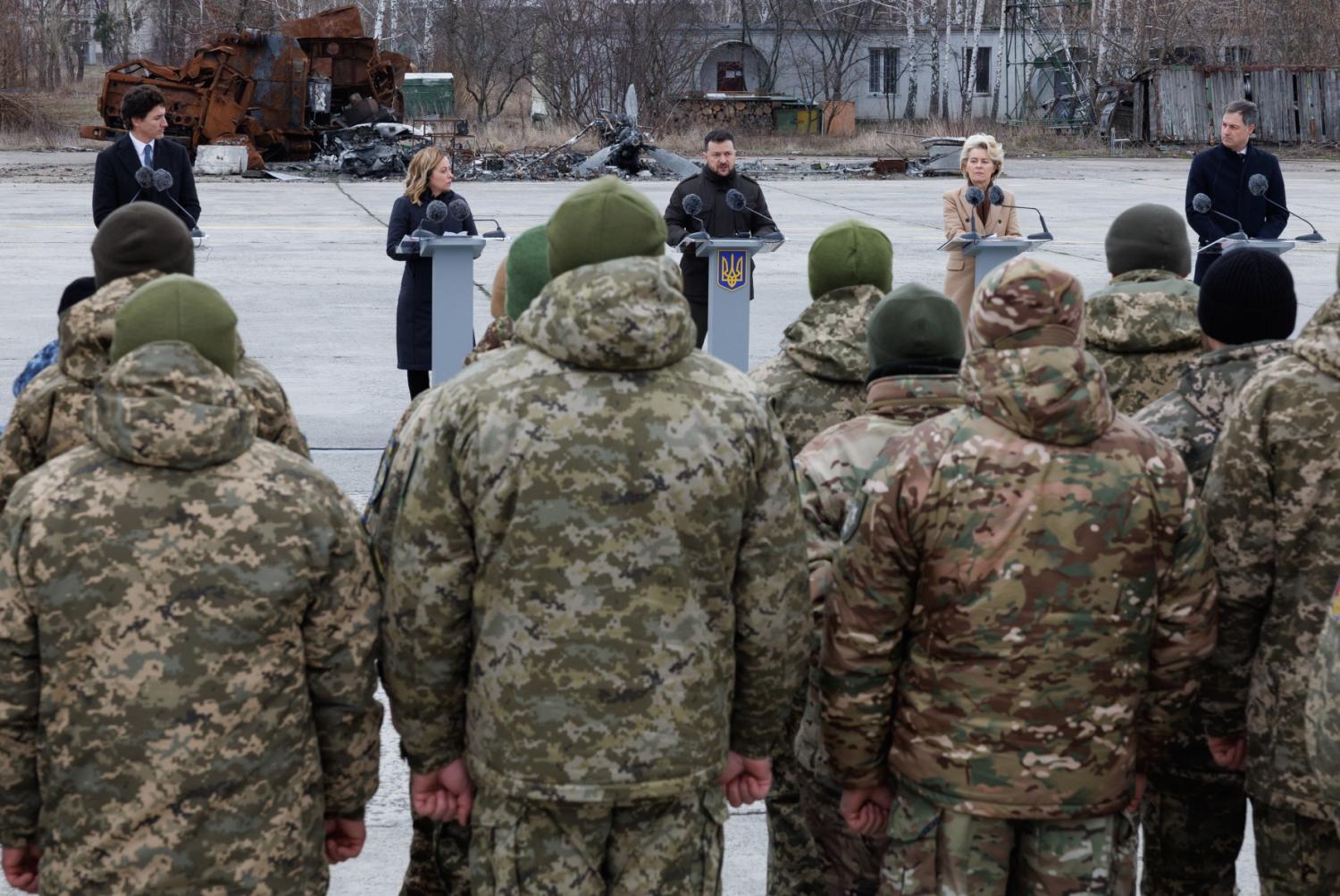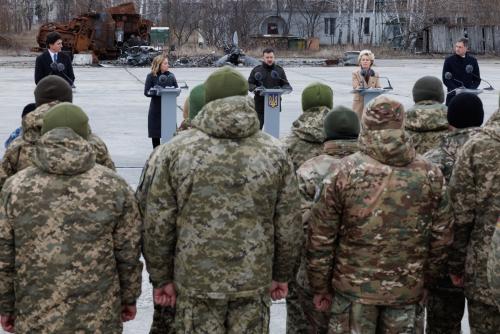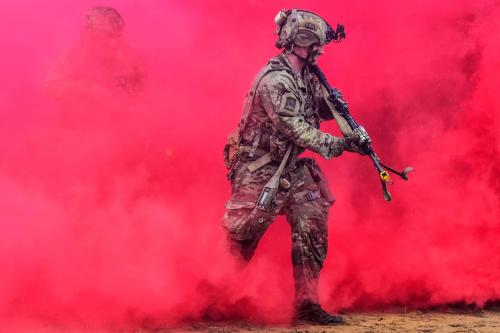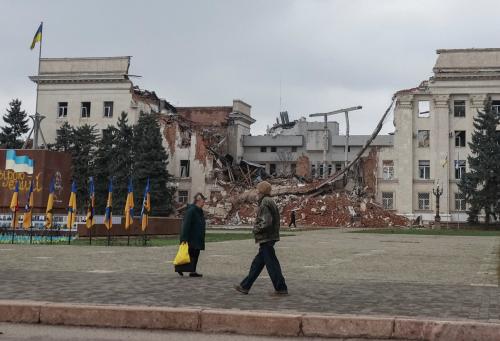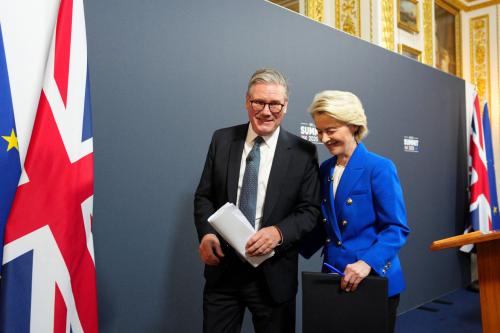This paper was written for a May 14 Center on the United States and Europe virtual workshop on “A new vision for European defense strategy?” as part of Brookings’s Reimagining Europe’s security project, along with Thomas Wright’s “How can Europe defend Ukraine?” and Liviu Horovitz and Claudia Major’s “Should Europeans develop an independent nuclear deterrent?”
The transatlantic security relationship today is shaped by the ambition to shift the burden of defense from the United States to Europe. Statements from the current U.S. administration suggest a willingness to withdraw at least some forces from the continent and make Article 5 guarantees conditional. Some European governments also fear that the United States could restrict weapons deliveries or intelligence sharing in a future crisis, leveraging access to critical systems for political ends.
The areas of European dependency on the United States have long been understood: Europe lacks strategic enablers, war-ready troops, and ammunition. What held Europe back was not ignorance but inertia. The first shock of Russia’s full-scale invasion of Ukraine triggered incremental progress. But even then, the United States remained the ultimate security guarantor and disciplining power of the European defense effort. The second shock—the return of Donald Trump to the U.S. presidency—has sharpened the stakes. To the extent that political will can be measured in resource allocation, Europe has understood this.
There is still hope for a responsible transition of responsibility, and European governments should continue to work toward that goal, in unity and in close coordination with the United States. But they must proceed under the assumption that the backstop of U.S. protection may not hold in the next crisis. The way ahead is clear, but two major challenges remain. The first is timing and sustainability: it will take years to translate increased spending into a stronger industrial base and deployable capability. The second is internal alignment: European governments remain divided on the objectives and governance of a defense posture less reliant on the United States.
The gaps in Europe’s conventional defense
Troop numbers and deployability
European NATO countries collectively maintain approximately 1.5 million active-duty personnel. On paper, this should allow them to meet NATO’s newest force model, which aims to make more than 100,000 troops available within 10 days, an additional 200,000 within 30 days, 500,000 within one to six months, and the Allied Reaction Force at short notice. In practice, Europe is not positioned to meet these targets. Despite the size of its forces, most of the troops under NATO’s plans would currently come from the United States, due to a lack of European combat readiness. European allies need to prepare to replace at least the 20,000 U.S. troops that were deployed to Europe as part of the post-invasion surge, and they should be ready for further U.S. force restructuring. They must work with U.S. leadership to make this an orderly process that will leave no dangerous security gaps.
Most Western European armed forces face growing personnel shortfalls and are now exploring various conscription models, drawing on lessons from Nordic and Baltic allies. Training cycles will need to be intensified for reservists, which some countries will need to reactivate in large numbers. For countries without a tradition of military preparedness, all this poses a politically and socially sensitive challenge that requires proactive political messaging. Additionally, to close the readiness gap across the continent, large-scale combined exercises must become routine. NATO recently fielded roughly 20,000 troops in collective drills—such efforts must expand. Another critical constraint to readiness is military mobility. In March 2025, the European Union’s (EU) defense commissioner estimated that €70 billion (about $80 billion) in investment is still needed to adapt Europe’s air, rail, road, and sea infrastructure for the rapid movement of troops and equipment. European defense spending targets must encompass plans to address these shortfalls.
Critical enablers
Even those European forces that are nominally deployable remain heavily dependent on the United States for strategic enablers. For decades, European capability planning within NATO has assumed a U.S. backstop, resulting in built-in dependencies and structural gaps. European militaries were designed to plug into U.S.-led coalitions, not to operate independently at scale. Among the most significant gaps is Europe’s lack of independent intelligence, surveillance, and reconnaissance (ISR) and target acquisition capabilities. Even with new ISR assets, European forces would currently struggle to operate them jointly; today, the United States ensures interoperability through personnel and system integration.
Ukraine’s experience highlighted the critical importance of integrated air and missile defense in combination with deep-strike capabilities. Suppression of enemy air defenses requires advanced electronic warfare, which Europe also currently lacks. Europe’s command and control infrastructure is still underpinned by U.S. personnel and systems. In addition, Europe does not have access to sufficient aerial refueling and strategic airlift capacity—NATO’s rapid deployment capability continues to rely on U.S. platforms to ensure reach and responsiveness.
European governments have begun to address these gaps, but time spans for different capabilities vary—some will be ready in a couple of years, while others will take a decade to fill. Some may take even longer than that. A recent report from the International Institute for Strategic Studies found that Europe’s defense industry is unlikely to fully replace key U.S. capabilities in the air and maritime domains within the next decade. Especially for the most expensive enablers, Europe will take time to catch up. To this end, it is essential that the intensity of the current spending effort is sustained beyond current legislative cycles. In the short term, Europe must embrace innovative (unmanned) technologies that can help bridge some gaps. NATO capability targets will be a useful guide, but Europeans should not limit themselves to whatever is decided at the forthcoming summit—the strategic situation remains in flux, but capability gaps are clear.
Ammunition
The war in Ukraine exposed severe shortages in European ammunition stockpiles and revealed critical weaknesses in Europe’s ability to replenish these supplies. Despite early delays caused by regulatory burdens, supply chain bottlenecks, and political constraints, European countries now appear on track for their end-of-2025 production targets. Yet these targets were primarily designed to meet Ukrainian battlefield demand, not to restore national inventories to sustainable levels. Countries still need to significantly expand production to meet the minimum ammunition stockpile requirements for their own forces.
Explosives production remains a major bottleneck. Europe currently operates only one major TNT factory, located in Poland, with another still under construction in Finland. This narrow capacity constrains the ability to scale the production of even basic munitions and shells. In the domain of high-end precision munitions, the gaps are even more acute. While new orders will help expand capacity, Europe’s missile producers still lack the long-term contracts and sustained public investment needed to build durable production lines at scale.
How to reorganize European defense
Defense investment and markets
European defense spending is rising across the continent, with a growing number of European countries expected to announce defense spending increases up to 5% of GDP ahead of the NATO summit (with most now aiming to allocate 3.5% to “core defense spending” and an additional 1.5% to “related expenditures”). Whether this moves the needle will necessarily depend on decisions taken in the largest economies. Germany has taken a key step by reforming its constitutional debt brake to accommodate defense spending. This measure speaks to the fact that the central question now is not only how to spend more, but how to do so within existing fiscal constraints. At the EU level, proposed changes to the Stability and Growth Pact aim to reassure member states that increased defense spending will not automatically trigger an excessive deficit procedure.
To address the financing challenge more directly, the EU is also experimenting with new instruments. A proposed €150 billion (about $170.6 billion) loan facility would use the EU budget to back sovereign borrowing, though repayment remains a long-term hurdle. Parallel efforts focus on unlocking private capital for defense, particularly by attracting investment into small firms and startups. Innovation in Europe has long been held back by risk-averse procurement models dominated by traditional defense primes. Recent changes to the European Investment Bank’s defense investment rules signal a broader cultural shift. Other, as yet unrealized, ideas include the creation of a European Defense Bank—a multilateral institution designed to crowd in private investment and provide long-term, low-interest loans for defense projects. The core obstacle remains: without large, long-term government orders to de-risk investment, defense firms cannot scale. At a more ambitious level, proposals for jointly issued EU defense bonds have gained some traction, though no political consensus has yet been formed.
All these mechanisms are attempts to navigate a structural reality: most European governments have limited fiscal headroom. Eurozone economies spend close to 20% of GDP on welfare, pensions, and social protections. But no government wants to trigger a guns-versus-butter debate. Cutting social spending to fund defense risks political backlash and could empower populist forces. Framing defense spending in terms of industrial policy, innovation, or job creation could help build political support—especially in member states facing fiscal pressure or rising public skepticism. However, these economic arguments must be carefully qualified. Defense is not a conventional growth engine and overstating its macroeconomic benefits risks undermining governments’ credibility. Ultimately, there are better reasons to invest in defense: preserving Europe’s security, sovereignty, and capacity to act in an increasingly contested world.
To this end, how money is spent matters as much as how much is spent. While European policymakers often acknowledge the inefficiencies of Europe’s fragmented defense market, few are willing to give up national control. Strong home bias in procurement and overlapping capabilities across member states continue to lead to duplication and wasted resources. Without some consolidation, Europe will struggle to scale rearmament at the necessary speed. A parallel challenge is reducing foreign—especially U.S.—leverage over European defense systems, particularly where export controls such as International Traffic in Arms Regulations (ITAR) constrain the use or transfer of critical technologies. This has prompted growing interest in developing ITAR-free systems to ensure European control over production and deployment. EU defense industrial subsidies’ strict award conditions respond to this impulse, aiming to strengthen Europe’s defense technology and industrial base.
These efforts and the realizations that underlie them are essential for Europe’s defense reorganization. But the process necessarily will be gradual. Deep capability dependencies will persist for years. Even nominally European platforms rely on U.S.-made components and cannot be exported without American approval. In many cases, long-standing transatlantic defense industrial cooperation will persist—neither side has an interest in disrupting established programs.
Meanwhile, Europe’s defense effort must remain outward facing. Foreign procurement will remain necessary, especially in domains where viable European alternatives are currently lacking or nonexistent. The EU already maintains structured defense partnerships with countries such as Japan and South Korea, covering cooperation on operations, cyber defense, and joint exercises. Norway, though outside the EU, participates in industrial programs through the European Economic Area.
Cooperation with third countries requires political will and work from both sides. But a formal defense agreement with the United Kingdom remains a critical gap—and a prerequisite for meaningful market consolidation. Europe should also work on improving political and security relations with Turkey, an important arms exporter, particularly to Eastern Europe. Most importantly, European countries should heavily invest in the Ukrainian defense industry, including by purchasing weapons from Ukrainian producers for Ukraine.
Neither full rationalization nor complete autonomy is realistic in the short term. Europe needs a roadmap for transition, which must include continued transatlantic defense industrial cooperation, combined with the build-up of key capabilities in Europe. The challenge is to manage fragmentation and dependency more deliberately—by aligning procurement where possible, investing in sovereign capabilities where necessary, and maintaining openness where it adds strategic value. There are trade-offs, but the influx of new funding into the European defense market will make it easier to absorb the costs of selective hedging where needed.
Defense governance and strategic coherence
Reorganizing Europe’s conventional defense is not just about filling capability gaps. It also requires making up for the role the United States has historically played as the disciplining and coalescing force for the continent’s defense policy, through military and political leadership. No single European country can realistically fill this leadership vacuum. What’s needed instead is a rethinking of European security and defense governance. Various models have been proposed—an autonomous European pillar within NATO, an EU Defense Union, or flexible intergovernmental coalitions. Each faces structural and political limits. Europe needs a defense governance framework that leverages institutional strengths, mitigates fragmentation, and produces strategic coherence without forcing artificial centralization.
The European Union has a distinct and increasingly important role to play—particularly on the industrial side. It is already at the center of a web of policies that support defense indirectly, including legislation on critical raw materials, semiconductor production, and dual-use technologies. It could lay the groundwork for deeper, more coordinated defense-industrial cooperation and integration for some flagship capability projects in Europe. Initiatives like the European Defense Fund have already begun to incentivize cooperation in research and development. If funded properly, its proposed successor, the European Defense Industrial Program, could expand that logic into procurement. Meanwhile, collective defense and standard setting remain NATO’s domain, and the alliance fields crucial structures, such as Supreme Headquarters Allied Powers Europe, or SHAPE, which cannot be easily replaced. But calls for a “European pillar” often lack operational clarity on whether this refers to a political ambition, an institutional redesign, or a fully autonomous European capacity to take over enabling roles currently filled by the United States. The latter would fundamentally shift the alliance’s center of gravity and would require NATO to find new ways to operate with significantly reduced U.S. input.
In practice, European defense operates as a patchwork. Different coalitions form around distinct missions, technologies, and requirements. Examples include the Franco-German-Spanish fighter project; the Joint Expeditionary Force, which provides a U.K.-led framework for high-readiness operations; and emerging long-range strike initiatives like ELSA, involving France, Germany, Italy, Sweden, the U.K., and Poland. These arrangements reflect overlapping interests, not a single defense blueprint. Politically, coalitions of the willing can act quickly, bypassing gridlock in larger institutions. Operationally, however, they lack access to institutional budgets and command-and-control infrastructure. What is more, left on their own, national defense bureaucracies tend to prioritize national defense industrial fiefdoms, undermining interoperability, duplicating costs, and fragmenting supply chains. It is possible to imagine ways around this, but any intergovernmental cooperation format that promises sustainable success requires an initial commitment by participating member-states to accept some sovereignty losses.
The layered reality of some institutional integration and cooperation and some nation-led initiatives leaves Europe with a persistent challenge: how to ensure strategic coherence across a decentralized system. An ambitious relaunch of NATO-EU cooperation is a must—after years of hollow progress, both institutions are changing in fundamental ways that make coordination both more desirable and accessible. But strategic coherence requires more than alignment on capabilities or institutions—it requires agreement on what Europe is defending, and why. Recent EU debates about whether to frame the current phase as one of “rearmament” or “readiness” reflect this deeper ambiguity. Terminology alone will not resolve it. What matters is whether Europe can define a common defense interest that justifies long-term investment, risk-sharing, and solidarity.
Over the past three years, the organizing principle of European defense has been clear: supporting Ukraine and deterring Russia. For many member states, that remains the central rationale. But others are focused on climate or migration-linked crises. That divergence is not inherently problematic—European unity does not require national threat perceptions to be identical. But true European defense does require a baseline of solidarity, particularly when it comes to investment force planning and related conscription debates. That solidarity must rest on two foundations. First, a shared recognition that the survival of the European political project itself is at stake in the face of accelerating global power shifts, and that responding to those shifts requires greater defense integration. Second, a security paradigm that respects both eastern and southern member states’ threat perceptions. A coherent European defense strategy must take all these concerns seriously.
A realist path to European rearmament
Europe’s task is to construct a more resilient, coherent, and capable defense posture—one that can function with less American involvement, absorb shocks, and reflect the full spectrum of European security interests.
Clear messaging from Washington would help. The Trump administration has signaled that it values deals over alliances, but the parameters of a new transatlantic defense deal remain undefined. The sooner the United States clarifies its future force posture in Europe, outlines the limits of its future engagement in Ukraine, and specifies whether its demands in the defense industrial sphere will in the future still be linked to security guarantees, the sooner Europeans can respond accordingly. Ideally, U.S. announcements should align with NATO timelines, to allow the alliance to adjust its capability planning. But even in the absence of clarity from Washington, Europe should press forward on its own terms.
The objective should not be to compensate like-for-like the role that the United States is currently playing in European defense, but instead to design a distinctly European defense policy and capacity. That will require sustained investment, political coordination, and difficult trade-offs across fiscal, industrial, and strategic domains. The foundation is already in place: The shocks of the war in Ukraine and U.S. retrenchment have generated momentum. But progress will remain fragile unless underpinned by a shared understanding of purpose. This does not require a single institutional breakthrough. In the years ahead, Europe should embrace alignment across institutions, coalitions, and national strategies. Strategic coherence does not mean uniformity. But without it, readiness will remain reactive, and rearmament will remain unmoored.
The Brookings Institution is committed to quality, independence, and impact.
We are supported by a diverse array of funders. In line with our values and policies, each Brookings publication represents the sole views of its author(s).


